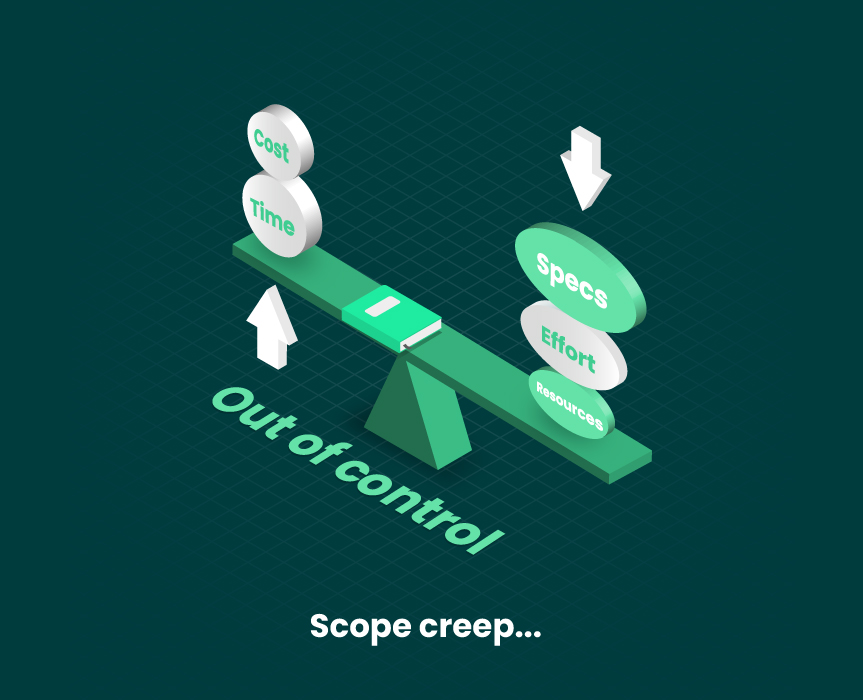They say the secret formula for successful project management is having a lot of money at the start. But if this rule worked, multi-mullion projects would never fail. Moreover, statistics show quite an opposite tendency. The bigger the business and project budget, the higher the chances for failure. In fact, challenges related to the project management process can occur in projects of different scales, timeframes, and scopes.
A recent study found that only 40% of all projects are successful and deliver full benefits. What about the rest? The rest fail to meet initial goals and go out of the designated budget. Not to be included in this 60%, you need to apply the best project management practices to prevent problems in the project.
But is project management as vital as people say? This video will give you the answer:
In other words, successful project management is an invisible power that prevents money losses and eliminates risks. Companies integrating project management practices waste 28 less money and improve their performance. However, project management is not always that smooth. Even successful project managers face many challenges, which we will discuss in the next section.
Project Management Challenges You May Face
Managing projects is not an easy task to take. Project managers have to ensure easy project start, effective project execution, and successful project finish. They bear responsibility for the efficient use of resources and have to create an effective work breakdown structure. Project managers may face the following challenges:
Unrealistic deadlines
Setting unrealistic deadlines is a common problem for both startuppers and experienced businessmen. No wonder, only 33% of all projects are delivered on time. The rest face expensive delays and shifts in project planning.
Imagine the situation: project founders are so excited about their idea that they can’t wait to implement it in the shortest terms. At first glance, it seems that the project team can bring it to life immediately. All stakeholders want to build a product on time and prevent competitors from outrunning them or stealing the idea. The team sets the deadlines and starts working.
After the start, it turns out that the project stages aren’t planned well. More time is needed for brainstorming. Much more resources are needed for unit testing and product promotion. The deadlines set initially turned out to be unrealistic. The whole project planning shifts. The team fails to meet expectations.
Solution: To avoid such situations and prevent project failure, you need effective project management. Hire a person who has good project management skills. They will reasonably conduct project planning. A good PM will provide you with an unbiased and data-driven analysis of all resources needed for successful project completion.
Scope creep
Have you heard about scope creep? This notion denotes situations when project requirements, goals, or expectations go beyond the initially defined ones. The frequency of scope creep cases is rising. Project Management Institute (PMI) reports that in 2021, nearly 62% of software projects experienced scope creep. Just to compare: in 2019, the figure was 57%.
As a rule, there are two reasons for this happening. First — a project is not planned well. What function would be the most important for users? What information to include on a landing page? How to use ads effectively? What tools to use to test the product? If unanswered, all these questions lead to changes and shifts along the way.

The second reason for scope creep is the lack of stakeholder involvement in a project. If stakeholder expectations are neglected in the beginning, they may be unsatisfied with the project in the end. To prevent this from happening, you need to consider their opinion at each stage of the project. It sometimes increases the volume of work to be done. This, in turn, causes planning shifts and leads to scope creep.
Solution: To deliver full benefits to the target audience, a successful project manager engages with a stakeholder from the very start. Based on their feedback, PMs define goals and set realistic deadlines. They conduct market analysis and choose the options that suit the project the best. At Forbytes, we also apply a 5-step project management formula that involves stakeholders and provides them with essential tools for tracking project status.
Ineffective communication
Poor communication leads to other negative outcomes. The most common one is a gap in the workflow. For every $1 billion invested in a project, $75 million is at risk because of poor communication style and practices used by a team.
A piece of news from a client neglected by a team leader can increase the time spent on product testing. The absence of regular sync-up meetings might result in the same work being done twice. And the list of such examples may be endless.
This problem frequently occurs in new teams. People have not adjusted to the project tempo and requirements yet. They do not want to bother their teammates to ask questions or announce changes. In the end, all the details that seem not so important turn into a snowball of delays, financial losses, and employee dissatisfaction.
Solution: A goal-oriented project manager sees a project as a system. They choose convenient project management software to ensure that everyone keeps pace with daily updates and project progress. A good project management tool is what can help you streamline teamwork and speed up development.
Effective communication is built with real-time text messaging and regular meetings. Open communication ensures that everyone is on the same page. Common goals are subdivided into tasks. Completed tasks, in turn, result in project achievements and progress.
Lack of accountability
On the one hand, you want to entrust the project process to a skilled person to save time. On the other hand, you also want to keep pace with everything on a project to feel safe about your money. An unclear reporting strategy and a lack of accountability are common problems you may face.
Almost 30% of the US workers name the lack of accountability as the biggest obstacle to success. For effective project management, reporting should be ensured both from the side of a project manager and a team. Team members have to report daily on their current tasks and progress. Meantime, a project manager has to provide a client with clear accountability to allow them to track overall project performance.
Solution: A client should have the opportunity to access project information anytime. They should be provided with a means of communication with direct team members if needed. In this way, clients will feel safe about their budget and project growth.
Financial difficulties
A business may run out of its budget unexpectedly when a project is still in progress. In this case, their fears of project failure only double, making the whole problem harder to solve. In most cases, high project costs block the project’s progress. A company has no resources to make things work. Setting unclear goals, choosing the wrong skillset, and neglecting the risks are the main causes of money waste.
Clarity of goals is an important factor at the project planning stage. A lack of clear goals leads to 37% of projects failing. To manage projects successfully, you should set SMART goals. Check out this video to learn what SMART stands for and how to make your goals SMART.
Choosing the wrong skill set is another reason for financial losses. Finding the right one is hard for people who have no tech background. How to know that the website development team you hire performs well? Choose a trusted project manager who will lead your team. A project manager will have a clear understanding of the tech competencies needed for achieving particular goals. With project management services, you make sure that you pay only for the skills you need.
Lastly, neglecting the risks is one more reason for money waste. Your software development team should have a risk management plan to be used when something goes out of control.
Solution: Your project manager has to consider all “what if” scenarios to allow your team to react promptly. Based on this knowledge, they have to develop an effective risk management plan. The plan will consider different types of risks, including financial.
Fundamentals of Successful Project Management
Let’s now move on to the steps you can take to ensure the successful management of your project. For this, we have consulted senior project managers at Forbytes. They have precious experience in overseeing successful project delivery and share the following tips with our readers:
1. Discuss project expectations
A list of goals for a project benefits everyone involved. It creates a clear sense of direction for the development team, which is one of the most important requirements for effective project management. Additionally, having a clear goal can raise your team’s morale and prevent people from burning out.
The clients have much to gain from it as well. A study found that 44% of projects fail because the goals of the business and the project are not aligned. Defining goals compels you to think about what you want your business to achieve. You align the goals of your business with the goals of the project, which greatly increases the chances of project success.
2. Define the scope
To ensure successful project management, outline the scope of your project as soon as you decide to launch it. What is the project scope? It is the volume of work to be done from start to finish, with deadlines set and resources outlined. Start with setting up the requirements and describing the processes involved in product development. Discuss the scope with project stakeholders to be aware of possible limitations.
But defining the scope is not only about setting goals and setting deadlines. This project stage involves more aspects. Your project manager should be ready to control both the project as a whole and each team member’s performance separately.

3. Choose and follow the right methodology
The right methodology gives us the keys to successful project management. It ensures effective project execution and delivery on a budget. PWC found that 97% of companies believe the right project management methodology can greatly increase business performance.
Nowadays, managers can choose from a variety of proven methods for project execution. Each has its pros and cons, and each works best under specific circumstances. Project executors may opt for Kanban, Waterfall, Agile, Scrum, Lean, and many others.
How to choose the best one? Everything depends on your project focus, the flexibility you can allow, and the complexity of the work. Compile a list of your project peculiarities and sort them by importance. Explore the pros and cons of each methodology and choose the one that covers the most crucial factors. If you lack the tech background necessary to analyze methodologies, contact the Forbytes team and get our prompt help.
4. Choose a relevant skillset
Hire the right people for your project. On the one hand, you should carefully consider each person’s competencies. On the other hand, you should pay attention to how the combination of people’s skills works together. It will help you create a collaborative and productive environment for your project.
More than 50% of companies recognize the increasing importance of soft skills. Apart from assigning test tasks, explore their communication skills. One of the interview templates available on the Internet can help you set the right direction for the conversation. Make sure that you choose flexible and open-minded people ready for life-long learning.
5. Set up milestones
Most successful project managers keep milestones in mind. Milestones are specific points on a timeline that mark project stages. They perform the function of sign points. Milestones indicate that one piece of work is done and it’s time to move to another. You can set up a monthly milestone for long-term projects and a weekly one for short-term projects.

What is the difference between a milestone and a goal? A goal is targeted at the future, while a milestone is looking back at what has already been done. With milestones, the entire team takes control of project progress and detects potential bottlenecks.
6. Manage documentation
On paper, everyone understands how important it is to keep it for reference. In practice, it happens that the process of preparing the documentation is postponed in favor of other project-related tasks. But what seems at the time like a mundane or time-wasting task can have an impact on the entire project.
Projects, especially long-lasting ones, are prone to staff turnover. Proper documentation is a great resource that your employees can refer to if they are not sure about a particular feature or function. This will save time and allow them to focus on their work.
Additionally, documentation can help you keep track of all decisions and changes made in the project. If you need to learn why the project went in a certain direction or why a particular decision was made — documentation will help you do it quickly.
7. Monitor daily progress
Make sharing daily updates a habit for your team. Apart from progress trackers, get information directly from your team members. It will help you set the right work tempo and increase the self-motivation of engineers.
Daily progress monitoring doesn’t take much time and allows you to detect workflow gaps promptly. A project manager has to see the difference between project, team, and employee deadlines. Even when you are far ahead of the project deadline, do not neglect the individual deadlines of your team members. Remember: one shift in the workflow leads to a shift in the whole planning.
8. Power up motivation in a team
When launching a tech project, do not forget about the well-being of your team. Best project managers know about the importance of well-mastered soft skills. They regularly find ways to engender employee motivation. A motivated team shows stable performance and high involvement in a project.
To power up motivation, a project manager has to conduct regular R&R (Recognition and Reward) sessions. Some people prefer to be praised in public, while others like to keep recognition private. An experienced project manager applies an individual approach to everyone. They understand when it is the right time to recognize one’s contribution and when it is better to discuss possible areas for improvement.
9. Consider risks
Risks can appear out of nowhere and may be difficult to predict. However, it is important to have a risk management strategy at hand that will help you adapt quickly. Again, having a project manager is particularly beneficial in such cases. They can implement strategies that will reduce the impact of negative risks or even prevent them altogether.
Moreover, an important thing to keep in mind here is that risks can be both negative and positive. An example of positive risk is a team overperforming and completing a task before the deadline. An experienced project manager not only can take advantage of positive risks, but they can also increase their impact on the project.
Some Extra Tips by Forbytes
We have described the elements of successful project management stories above. Yet, here are some additional pro tips that the Forbytes project management team applies in their daily practice. Use these tips, and it’ll be easier for you to manage projects effectively.
Log all issues
If your team underperforms, log the issues. If your team outperforms, log everything as well. Noticing changes at one stage will help you optimize the work at the next stage. It will save you money and time that could be spent on building additional product features or advertising.
Give your team a voice
Cultivate knowledge sharing in your team. Keep in mind that each team member has a different tech background and diverse experience of past projects. Giving them a voice and allowing them to share ideas will help you make your project better. Synthesizing all ideas may inspire you to make essential product improvements.
Stay flexible
Stick to the project plan but don’t be afraid of changes. When some changes happen, don’t let them turn project management into a mess. Be ready to adjust to the new circumstances and leave room for flexibility.
To Wrap It Up
There is a long way to go when it comes to successful project completion. From choosing the right skill set to selecting an effective methodology — everything matters. Experienced project managers can help you ensure that a project reaches success and brings value to your business.
So, if you need assistance with your project – feel free to contact our team.

Our Engineers
Can Help
Are you ready to discover all benefits of running a business in the digital era?

Our Engineers
Can Help
Are you ready to discover all benefits of running a business in the digital era?








